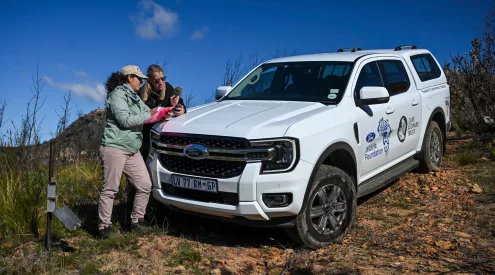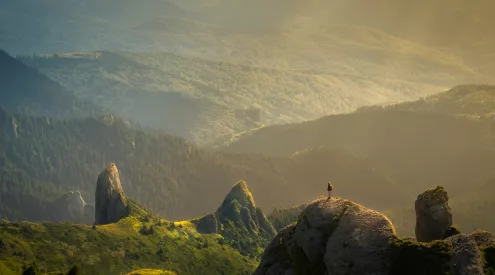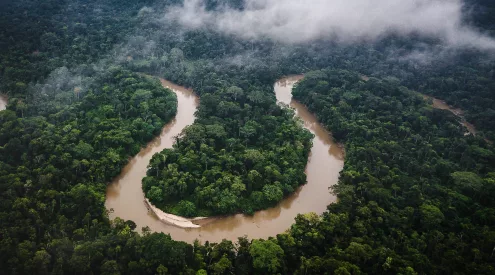If only there was perfect equilibrium between profit, people and the environment. But there isn’t – and protecting the environment counts on eco-tourism embracing community participation.
If you’ve ever looked at a pristine piece of land in full bloom in spring and yearned to return to it year after year, you know how deep the nature bug can bite. But chances are some developer will come along and build something on the land, erasing forever the pleasures it once held. The dream scenario would be if there were a perfect equilibrium between the environment, people and profit. But life’s not like that and South Africa faces tough choices ahead.
Land reform and eco-tourism

The long beaches of iSimangaliso Wetland Park stretch for more than 250kms. Photo by Scott Ramsay.
It’s now accepted that land reform in this country hasn’t worked well and communities remain impoverished despite the potential of their assets. What makes the issue even more urgent is perhaps best highlighted by land claims at iSimangaliso Wetland Park, a World Heritage Site. Claimants have identified over 70 percent of the park as belonging to them, indicating the scope of the problem. Many of those claiming ownership no longer live on the land – they had to make way for developments, including commercial and conservation ones. Even as this iconic piece of land continues to embody many of the contesting uses for land, the issue of those living within the Dukuduku Forest has been well documented.
It’s one of the longest-running land claims sagas. The ‘squatters’ have fought against efforts to evict them, saying the land belongs to their ancestors and insisting on their rights to live off the forest as hunters and gatherers. The declaration of this area as a World Heritage Site has merely served to reinforce the need to resolve the matter of how best to use the land.
It’s clear that no other industry highlights the environment versus development tension quite like eco-tourism. This is especially true because nature was very generous when endowing South Africa with such a richly diverse natural habitat and resource base. And at a time when it’s clear that mineral resources are finite, it becomes even more apparent why eco-tourism holds the key to South Africa’s future. But it’s also abundantly obvious why it can’t be business as usual: conservation cannot succeed if it doesn’t benefit those who live next to resources. When community members turn to poaching or pillaging prized timber for firewood so that they can eke out a living, it shows a failed model for sustainable development. It makes no sense for any entrepreneur to develop world-class facilities that attract rich tourists if neighbouring communities don’t have a stake in the success of the enterprise. Sadly, many entrepreneurs regard this as a kind of grudge purchase and don’t embrace it.
(Read: Hunting and eco-tourism in the Pafuri/Makuleke concession)
Local communities should be seen as an essential part of any truly sustainable nature-based business, rather than as a problem. South Africans are well known for working things out, so it’s a little surprising for many to see how much still has to be done to find what could be considered a win-win between the environment and development lobbies. One doesn’t need to be a cynic to see that where profit is involved, it becomes tricky to simply talk of meaningful community participation as the magic wand to solve the tensions between the two sides.
Then there’s another issue: in practice, there is nothing like a homogenous community. Often community members have their own interests and objectives, and smart entrepreneurs use these to neutralise the community and increase their own advantage. There are many stories where development agencies funded what on paper looked like solid community projects, only for these to fail or even be vandalised by the very community that was meant to own the assets. Dinokeng Big Five Game Reserve, for example, faced the threat of vandalism when it opened; fences were broken down and police were called in to protect the reserve.
The truth is that entrepreneurs want to make a profit, and they typically have the know-how and the resources to obtain returns on their investments. It takes exceptional negotiation skills to persuade them to share these returns with anyone else. As for communities, even when they own the land or have lodged a land claim, they’re often poorly organised and not able to participate as equal commercial partners. This means that when they strike deals, they often do so from a position of weakness.
There have been success stories (see below on how Namibia’s getting it right), especially when the partnerships between entrepreneurs and local communities are based on independent but mutually reinforcing interests. They ensure that each of the parties is invested in the relationship. One question that always needs answering is who benefits from any development – the answer gives a clue as to who suffers, as very few developments have no unintended victims.
Dr Ian Player is a great example of motivating opposing sides to buy into a single cause. He convinced the State to bring the private sector into conservation efforts at a time when the rhino population had fallen catastrophically low with the hope that private game reserves would breed rhinos and so grow the population. Looking back, it was a stroke of genius.
It’s time for our generation to create win-win scenarios like this. Those who advocate environmental protection policies that only make people poorer should ask themselves how sustainable their approach is – the challenge of our day is to engage millions of community members who currently don’t stand to benefit significantly from protecting the environment.
The tension between development and protecting the environment is only going to worsen. Poverty and a poorly protected environment go hand in hand. Whether it’s in urban shanties or rural communities, sustainable development can succeed only if the ordinary people believe their lives will be improved by caring for the environment.
Success story by Scott Ramsay

This reminded me of the scene in first Hobbit movie: The lonely mountain is Klein Spitzkop as seen looking west from the main Spitzkop campsite in Namibia. Photo by Chris Davies.
In the early 1990s, after the SA army had decimated much of the wildlife, the Namibian government granted communities legal rights to their traditional land, giving ownership of the remaining wildlife to people who were once poachers. The Ovambo, Kavango, Herero, Himba and Damara people could choose how best to make a sustainable living. Almost every community chose to conserve their wild animals.
In 1998, the first formal conservancy was registered. Today there are more than 79, covering about 20 percent of the country and creating more than 1000 permanent jobs. As John Kasaona, a community leader in conservation, said: ‘This is our new economy, an economy based on the respect for our natural resources.’
Conservancies and national parks now formally conserve almost half of Namibia, one of the highest figures in the world. Wildlife numbers have responded dramatically. After almost becoming extinct, the free-roaming black rhino population is the largest in Africa and Namibia has the only expanding population of wild lions, while numbers of the famous desert-adapted elephants have at least tripled.
This article first appeared in the September 2014 issue of Getaway Magazine.


















